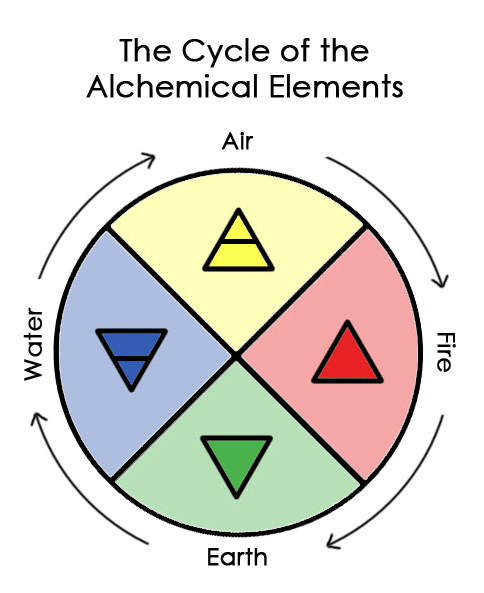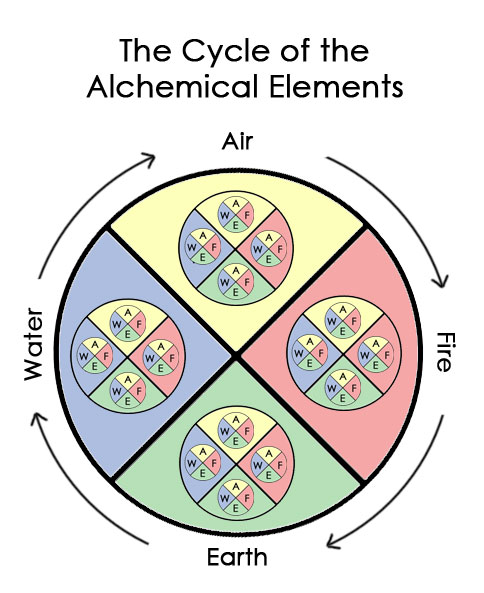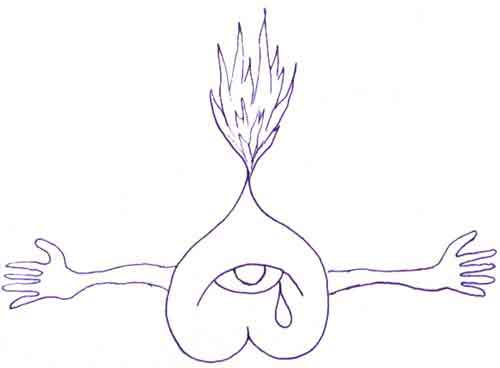Chapter 7: Review and Summary Example: The Alchemy of the Image
The Elemental Mandala
The reader should recognize that the approach to the elements taken so far in this chapter is primarily indicative of the Earth element. To a minor extent some relations between the elements have been brought to light (Water), but a comprehensive picture is missing. This should bring to awareness a whole new level of thinking with respect to the elements: perhaps in the form of the following question: “What if the system of the elements were to be applied to itself?” This presents an interesting test of the system at the Fire level. If the system claims that there is a Fire level, which is somehow the reaching towards an archetype or driving, unifying principle, then what would this Fire level be for the system of the elements as a whole?
Here words and concepts begin to fail us, in the sense that no individual sentence or phrase can embody the principle entirely. Not even the linking of sentences can do it. Rather, we must shift our thinking itself – we must make our thinking elemental. This requires a certain capacity for intuition and a willingness to surrender what one already knows in order to let the process itself lead one forward. We could say that a proper examination of the Fire element will lead one into an understanding of the whole of the four elements: as facts, processes, polarities, and as wholes, which themselves all form a single, more encompassing whole – the archetype of the elemental process itself.
Now we can make explicit, in an image, something of the nature of this process, using the signs discussed above. Working to understand the Fire level of the image leads to a larger picture of how everything fits together to make a single, coherent process. Each individual element exists as a manifestation of the Fire element itself. Although speaking of the elements in this way may seem elliptical, it is meant to be both explicit and exact – because at the Fire level, it is not only the specific nature of Fire that must be addressed, but the whole itself, including all the previous elements.
Thus we come to recognize the larger nature of the Fire element, both in its inexpressibility and its all-encompassing nature. We can see that as a cycle, the Fire element leads to a new Earth. We can show this relation through a sequence of images, pictured below.

We begin with the symbol for Fire at stage A. This Fire does not arise arbitrarily but is a direct consequence of the ongoing evolution and transformation of the facts of the Earth level. No individual fact, nor all of the individual facts together can make the Fire. Rather, the arrival at the Fire level is simultaneously accomplished along with the transformation of each individual fact into its own Fire state. It is precisely the coherent, interconnected, simultaneous transformation of each individual fact in the context of the whole that allows the whole to arise for us – they are one and the same process. This is represented in stage B, where three individual Earths have been simultaneously transformed through the elemental cycle to the Fire level in a lawfully connected way, forming the larger Fire triangle. The arrow points both ways to indicate that stages A and B are actually interchangable and identical.
The coming together of all the transformed Earths has led to something new, embedded within the original Fire element, and it looks suspiciously like a symbol we have already encountered! It is a New Earth. The experience at the Fire level is generally not one to be sustained: the activity of the Fire quite quickly expands beyond the capacity of the individual system to contain it. This is represented at stage C, where we picture the individual Fire elements flying away in all directions, toward the infinite periphery. We could say that the contents of the original Earth facts combust themselves in their transformative Fire process, but while they leave their old natures behind, they do not simply disappear. Rather, all of the bits of Earth form out of their combined burning/transformation something which falls out of the process and is ‘left behind’, pictured above at stage D. What we are left with is an insight – not the activity that produced the insight, which has now disappeared from our view. This insight becomes a new ‘fact’, which can itself evolve through the process again towards its own Fire state, signified by the looped arrow to stage A; the loop can actually represent another complete cycle through the elemental mandala, but one that works at a higher level, as if moving along a spiral. The actual Fire sign itself is thus revealed to be an alchemical crucible for the transformation of its own constituent Earths. This is an exact analogy for the spiritual alchemical work undertaken by an adept.

With respect to the discussion of images, our Fiery insight yields up a new sign: the elemental mandala pictured above. Thus, by undertaking the alchemical cycle with the signs for the alchemical cycle, we are led to a new sign – one which embodies, integrates, and completes in a coherent package all of the previous stages. Alchemists would call the production of this new Earth an ash. This new sign, the mandala, implicitly expresses the overall meaning and interrelationship of the individual signs in a singular representation, so that the feeling of the whole takes on a quality of rightness that is lacking in any of the individual elements taken out of this context.
The development of this quality of exact imagination is ultimately one of the major reasons for the use of images by the alchemists themselves. It was implicitly (and sometimes explicitly) recognized that the alchemical language of the image could act as both a carrier of the content of the practice of alchemy, while also serving as a key that unlocks the alchemical process itself in the developing alchemist. In other words, the alchemist, in order to glean the meaning of the content of the alchemical image, had to work with the alchemical cycle – but the image itself actually served as a guide and teacher to the alchemist, training him or her in the very faculty required to read the image. Thus, alchemical images are meant to be not simply bearers of content, but transformative agents.
The archetype of alchemical images is to act as a direct teaching of the alchemical process itself – not as a specific content but as a living process. In this way the image can act as a transformative process in the viewer. Marie Louise von Franz, a pupil of Jung, points out this power inherent in the symbol:
Jung called the symbol-making function of the unconscious ‘transcendent’, for not only does it transcend our conscious grasp, but it is the one thing which, through symbol-formation, enables man to pass from one state to another. We would be forever stuck in an acquired habit of consciousness if this transcendent function of the psyche did not help us over into new attitudes, by creating the symbol, which shares in both worlds. The symbol is associated with both present and future psychic states, and therefore helps us over. 38
Although here interpreted psychologically, with our modified understanding of the elemental cycle we can see how it is the archetype itself which helps us with this transformation from one state to another. The image is then experienced to be a coagulation of the archetype – in other words, the Fire level of the image is the archetype. The primary difference between alchemical images and other images has to do with the fact that the alchemist, in creating the image in the first place, has already worked through multiple cycles of the elemental process, so that the new Earth of the image embodies all the stages that have come before. We could say that the image is ‘warmed’, having already been through a process of ‘digestion’.
This consideration leads us to a further understanding, which has been implicit in all of the above discussion both in its form and content, viz. the fractal nature of the alchemical process. It becomes clear that each element is not fundamentally ‘pure’ in the atomic sense of the word. Rather, each element is actually a particular expression of the whole process itself. That is, the alchemical process can be said to consist of nothing but itself – its own archetype – its being. We can formulate a new image expressive of this fact, although with the recognition that at these levels such a thing cannot be actually embodied, in words or images, but can only be hinted at. Thus, the process is infinite and fractal – self-similar at all scales. This is a new way of getting at the idea which alchemists called the ‘prima materia’ – which is both heavenly and earthly, one and many at the same time.

The signs for the elements are therefore somewhat unique in their character, as the images are pictures of themselves – of their own archetypal processes. Although the alchemical process can be used to examine any image, when used to examine the elemental symbols, the process becomes doubly self-reflexive. This transforms the signs themselves into keys for their own unlocking. Here we see a real example of the highest alchemical principle in action: as above, so below, as below, so above. And we can see that this must be the case – that the alchemical cycle of the elements, all the way from its archetype to its physical manifestation in signs, must holographically carry the meaning of the whole.
Let us now return to our starting point and see if we have made any progress. What is useful about an alchemical approach to images? What does it teach us about the image that may be missing otherwise? Let us use our new-found tool, the alchemical mandala, to very briefly address this question. At the Earth level, we can see that images are not simply facts, but are multilayered manifestations of hidden (but not secret) realities; they are signs. In Water, we notice that these manifestations arise through a specific process and are expressive of relations; they are ciphers. In Air, we notice that images additionally have the capacity to bridge the inner and outer worlds, and thus can act as potent tools for communication (or manipulation!); they are symbols. The Fire tells us that images even have the capacity to transform us in profound ways, because ultimately everything is an image of the Fire; they are archetypes.
An alchemical approach to images, in true alchemy-style, leads beyond a strict consideration of images into the field of transformation itself. It should by now be obvious that the archetypal nature of the elemental process truly is archetypal, working as an active patterning principle by virtue of which manifestation occurs, both in images and elsewhere. Thus, the elemental mandala, as an archetype, is expressive of transformation itself, and can therefore be fruitfully applied in any arena in which transformation occurs. And this, as the Rosicrucian saying “This too, shall pass” subtly implies, means essentially every process. The elemental mandala is powerful tool that can be used for efficiency and directness in understanding any situation involving transformation.
In other words, the discussions taken up in this paper can be approached from the perspective of any single element. Yet it is only by actually working through the cycle experientially from Earth to Fire that you, the reader, will be able to discover the extent to which there is more to these words than simple dust.

Footnotes:
38: Back Quoted from “In the Hands of Alchemy” website at http://www.handsofalchemy.com/ourwork/talks.htm




